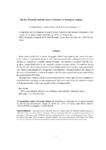Market potential and the curse of distance in European regions

Use this link to cite
http://hdl.handle.net/2183/15382Collections
- Investigación (FEE) [923]
Metadata
Show full item recordTitle
Market potential and the curse of distance in European regionsDate
2014-06Center/Dept./Entity
Departamento de Análise Económica, Grupo C+DAbstract
[Abstract] In the context of the New Economic Geography (NEG) wage equation, the ‘curse of distance’ is the tendency of peripheral regions to have lower income because of being far from the main markets, as captured by a variable Market Potential. This pattern is consistent with the core-periphery spatial distribution of the European regional economic activity. Nevertheless, during the last decades, the European Union has been implemented active transport and regional policies, which should mitigate the consequences of peripherality. This paper analyzes the changes of the cross-sectional effects of Market Potential on the European regional income per capita during the sample period 1995-2008.
The paper finds evidence that the cross-sectional elasticity of per capita income to Market Potential has been decreasing over the sample period. However, some results are sensitive to changes in the specification of the wage equation or the estimation method.
Keywords
NEG
Wage equation
Distance
Core-periphery
Regional policy
European regions
Wage equation
Distance
Core-periphery
Regional policy
European regions
Editor version
Rights
Reconocimiento 4.0 Internacional






